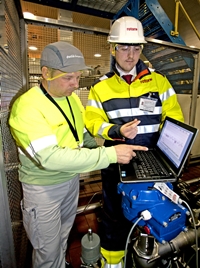Rotork CVA electric control valve actuation technology is helping Coca-Cola Enterprises (CCE) to increase efficiency and reduce energy costs at its Wakefield production plant. Since installing and acting on the information produced by an Energy Monitoring system, the company has so-far reduced electricity consumption at Wakefield by 13% since 2009.
An important part of the plan involves saving the on-going cost of providing and maintaining an instrument air supply for traditional pneumatic control valve actuation. This is being implemented at Wakefield by the introduction of the Rotork CVA control valve actuator to perform modulating and failsafe valve duties.
Photo courtesy of Rotork
Andy Reynolds, Automation Engineer at the Wakefield plant, takes up the story:
“We were looking for an alternative to pneumatic control valves in order to remove the need for compressed air as much as possible in the area and reduce costs. Based on average air usage of 2m3/hr for a 3” control valve at GBP 0.05 per m3, the running cost would be GBP 870 per annum. The CVA actuator, using an average of 10 Watts at GBP 0.15/kW, would cost GBP 13 for the same period. This represents a minimum saving of GBP 857 per annum per valve, as this figure does not take into consideration any leaks in the system.
“Up to now, electrically actuated valves could not respond fast enough to maintain good pressure control in the bottle filling machine. Rotork were confident that their CVA actuator would not only give a similar performance to our existing valve, but would also be cheaper to run. Their confidence was so high they offered us an actuator on a sale or return basis if it did not meet expectations in any way.
“To prove this, the performance of the existing pneumatic control valve on the main product feed into the filling machine was first monitored and recorded. Using an adaptor made at Rotork’s facility in Leeds, the CVA actuator was then fitted to the same valve and connected to the existing 4-20mA control signal from the PLC.
“After running and monitoring the CVA actuator in a 24-7 operation for 1 month, the results from the two actuators were compared. The graphs clearly show that in production mode the CVA performs equally well, if not better than the pneumatic actuator. However, when in CIP (Clean in Place) cleaning mode, the performance of the CVA is much better than the pneumatic. This is because the CVA actuator does not overshoot the set point like the pneumatic actuator does when the set point is lower and back pressure in the circuit is higher when in CIP mode.”


